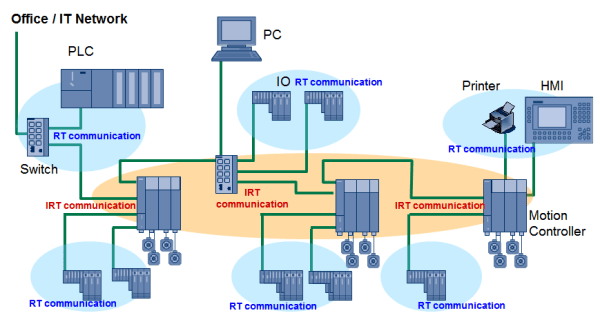The EtherNet/IP folks just can’t stop talking about PROFINET… and just can’t stop getting it wrong. It’s almost like they’re deliberately misrepresenting PROFINET. The latest example is in the Industrial Ethernet Book article “Working successful motion control via standard Ethernet.”
The article has no new FUD*; I’ve been calling them out on this same thing for five years; check past blog posts on the topic. The gist is: PROFINET is standard, unmodified Ethernet. It uses TCP/IP, but not for real-time. TCP/IP and UDP/IP introduce variability and time delays; skipping them and going straight to the application layer eliminates those problems. Many standard IT protocols skip TCP/IP, too (Address Resolution Protocol, for example).
The diagram in the article says that PROFINET needs to go through a gateway in order to connect to non-motion devices. That is wrong. This is right:
The only requirement is that motion devices be connected directly to each other or through an Ethernet switch that is IRT-aware. (Since most devices have at least two Ethernet ports, an external switch is seldom required.) IRT is short for Isochronous Real Time. It provides for bandwidth reservation on the network so motion control traffic always gets through without interference from non-IRT traffic, like TCP/IP traffic. In other words, if any traffic suffers, it’s the non-IRT traffic. So, in our diagram, the PC in the upper middle can print to the printer that is connected through the motion control segment. You could also have an Internet protocol camera connected to the HMI computer through the motion control segment showing real-time video. Neither printing nor video interferes with motion control and certainly does not require a gateway.
This video shows what happens with and without IRT:
EtherNet/IP does not have IRT, so what happens when they have a heavily loaded network?
–Carl Henning
*What’s FUD? Fear, uncertainty, and doubt (FUD) is a sales or marketing strategy of disseminating negative (and vague) information on a competitor’s product, according to the FUD article at Wikipedia.
